A Complete Guide to Kitchen Layouts
The key to a functional and user-friendly kitchen lies in its layout. With the right design, you can transform your kitchen into a space that not only looks great but also makes cooking and entertaining a breeze.
The common kitchen layouts include:
U-shaped
G-shaped
L-shaped
Single wall
Galley
Island
Peninsula
Based on years of creating our customers’ dream kitchens, we understand the need to choose the right layout. By learning about each layout, you can guarantee a kitchen that is not only visually stunning but also perfectly suited to your everyday needs.
The Common Kitchen Layouts
U-Shaped Kitchen Layout
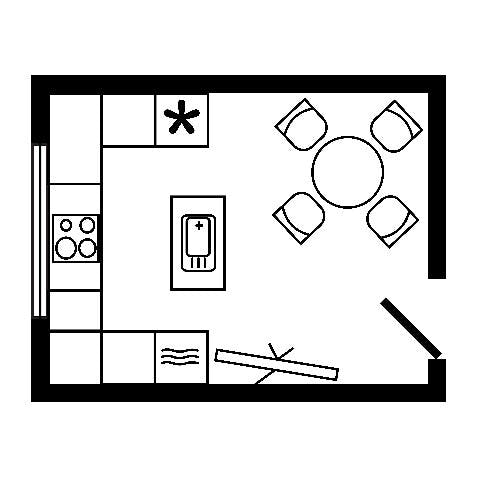
The U-shaped kitchen, also called a horseshoe kitchen, features counters and cabinets on three sides, forming a U. This type of layout is common in older homes and is known to be one of the most efficient layouts. It provides ample counter space and storage options, ideal for food prep and cooking.
Key Features:
- Efficient work triangle- this layout supports an effective work triangle between the stove, sink, and fridge.
- Ample storage- because of the cabinets lining three walls, there is plenty of storage space available.
- Suitable for multiple cooks- a great choice for families or those who love to entertain, the U-shape provides plenty of space for many people in the kitchen at once.
- Versatility- the U-shaped can be adapted to different kitchen sizes, although it works best in medium to large kitchens.
Ideal for: medium to large kitchens
G-Shaped Kitchen Layout
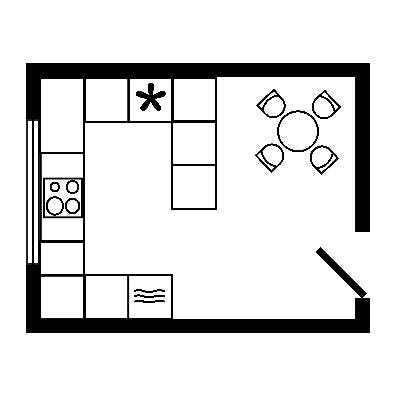
An extension of the U-shaped layout, the G-shape features cabinetry and counters on three sides, with an additional partial fourth side or a kitchen island, forming a G. This layout provides storage and counter space, maximizing efficiency and functionality.
Key Features:
- Enhanced workspace- ideal for food prep, cooking, and serving, the ample counter space of the G-shaped kitchen can be used for many purposes. The added peninsula can become a breakfast bar or additional prep space.
- Increased storage- like the U-shaped kitchen, this layout provides the most storage space, perfect for a well-organized kitchen.
- Efficient work triangle- this layout takes advantage of the work triangle, optimizing the workflow between the fridge, oven, and sink.
- Defined workspace- the added peninsula clearly defines the kitchen space in an open-concept home.
Ideal for: medium to large kitchens
L-Shaped Kitchen Layout
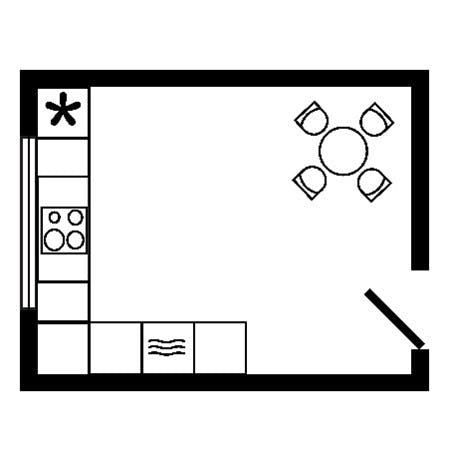
An L-shaped kitchen layout is celebrated for its versatility and adaptability, making it a favorite among homeowners and designers. This layout forms a natural corner where two perpendicular walls meet, creating the shape of the letter "L."
Key Features:
- Ergonomic design- allows for a seamless and efficient work triangle and minimizes the number of steps taken while prepping and cooking.
- Maximizes corner space- often underused, the L-shape layout uses the corner space for ample storage. Lazy Susans are a great way to utilize the corner cabinet.
- Ideal for an open floor plan- the L-shape naturally transitions into other living spaces, fostering an inviting environment.
- Works with all sized kitchens- the L-shape scales to fit any size kitchen, both large and small.
Ideal for: all kitchen sizes
Single Wall Kitchen Layout
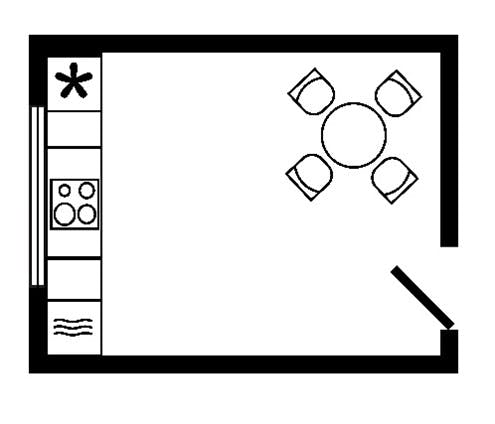
Great for minimalist design and small spaces, the single wall layout stands out for its simplicity, making it the perfect choice for small apartments. Sometimes referred to as an I-shaped design, it aligns your cabinets, counters, and appliances along a single wall, creating a sleek and cohesive look.
Key Features:
- Streamlined efficiency- by consolidating the fridge, stove, and sink along one wall, there is minimal movement between tasks. This allows for a more organized and less cluttered cooking environment.
- Space saver- the single wall layout makes the kitchen feel open and airy, despite its small footprint.
- Aesthetically appealing- this layout makes a statement in its simplicity. Without the interruption of corners, it showcases beautiful cabinetry and appliances.
Ideal for: small kitchens/studio apartments
Galley Kitchen Layout
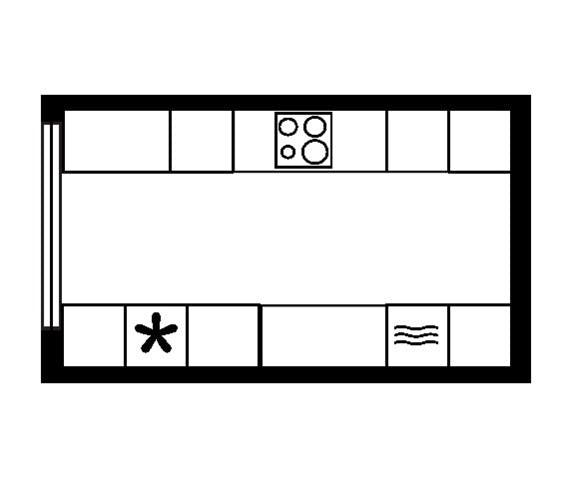
Named after the compact and efficient kitchens on ships, the galley kitchen is characterized by its narrow, corridor-like shape, with parallel countertops. This layout celebrates simplicity and functionality.
Key Features:
- Efficient- the basis of the galley design is the promotion of quick, easy, and efficient meal prep.
- Embraces limited spaces- its linear design makes the best use of small spaces without sacrificing functionality. The galley kitchen makes every inch count in the kitchen, especially with practical storage solutions and proper appliance placement.
- Streamlined aesthetic- both sleek and modern, this layout features clean lines and symmetrical design, perfect for the clutter-free minimalist.
- Flexibility- despite its clearly defined structure, the galley kitchen is flexible when it comes to personalization. You can open one end for a semi-open layout or incorporate a small dining area. The choice of cabinetry and finishes will influence the kitchen’s character, from rustic to ultra-modern.
Ideal for: small kitchens
Peninsula Kitchen Layout
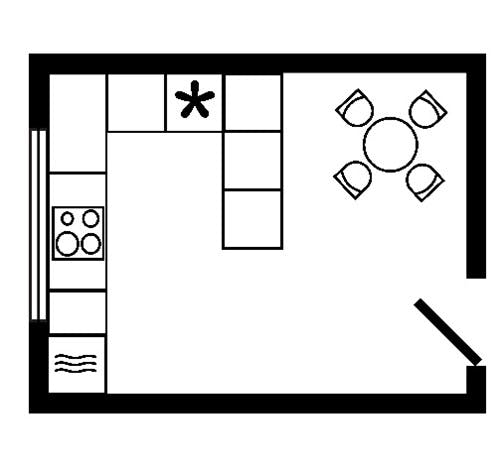
A beacon of versatility and ingenuity, this layout blends the efficiency of the classic work triangle with modern living. This type of layout features a countertop extension that juts out from a wall or cabinetry, creating a space that can serve multiple purposes without the commitment of a full island.
Key Features:
- Seamless integration- the peninsula acts as a bridge between the kitchen and surrounding areas, promoting an open yet defined space. This allows for interaction with those in both areas, without compromising on functionality.
- Versatility- the peninsula serves as a hub for many activities, like eating, meal prep, seating, and socializing.
- Great for small spaces- the peninsula adds the benefits of an island without requiring additional floor space. Ideally, there should be at least 36 inches of clearance around the peninsula to ensure a comfortable flow of traffic.
Ideal for: small to medium kitchens
Island Kitchen Layout

A hallmark of contemporary and stylish home design, the island has become the most wanted feature in kitchens. A freestanding unit in the kitchen, the island is a statement piece, gathering spot, and ideal meal prep space, an essential part of modern living.
Key Features:
- Versatility- accessible from all sides, it is a multi-functional hub ideal for gathering with friends, cooking dinner, and dining.
- Enhanced functionality- the island offers additional storage space that facilitates a smoother workflow.
- Flexibility- the island is adaptable to various sized kitchens, thanks to its customization abilities. It can be expanded to fill large kitchens and compacted for smaller kitchens as a much-needed counter space.
- When designing your island, it's important to avoid kitchen island design mistakes such as making the island too big for your space, having too many seats at the island or peninsula, and placing your island in the wrong spot.
Ideal for: any size kitchen
What To Keep in Mind When Choosing Your Kitchen Layout

When choosing your kitchen layout, it is important to consider functionality, flow, aesthetics, and what your unique needs are for your kitchen.
- Measure your kitchen space to know which layouts are ideal.
- Assess your storage requirements and plan for enough cabinets, drawers, and pantry space.
- Determine how much counter space you need and see which layout fits best.
- Consider how the appliances will impact the workflow in your kitchen.
- Think about task lighting in meal prep areas.
- If you want your kitchen to be a social hub, consider ample seating around an island or peninsula.
- Choose a style that compliments the overall style of your home.
- Keep your budget in mind and be realistic about how it will impact the work needed and what you wish to incorporate into your design.
After choosing your preferred layout, the fun part begins- designing the space. Thinking about where your fridge will go, the ideal placement for your pantry, and whether you should incorporate an island are all important points to consider.
To save you some time, we have compiled a list of what homeowners wish they would have known before designing their kitchen.
Top Tips When Designing Your Kitchen

- A proper and efficient hood vent that vents outside is essential. Some hoods release the hot air directly back into the room, which makes having a hood pointless.
- Plan out where your trash cans will go.
- Get a quote from an electrician and plumber to assess any utility work that may be needed.
- Save a space for a pantry- even a small one.
- Make sure your backsplash and cabinets can be easily cleaned and wiped down.
- Consider a pull-out spice cabinet to make viewing your spice inventory as simple as possible.
- Hire a professional whenever possible- especially when it comes to doing heavy-duty work. Never consider doing utility work or installing countertops yourself unless you have the experience and qualifications.
- Invest in quality materials for counters and cabinets- you’ll be thankful in the long run.
- Make sure the doors of the fridge, oven, and dishwasher do not impede any movement in the kitchen.
- Provide each area of your kitchen with proper lighting- general lighting, task lighting, undercabinet lighting, and accent lighting are all important.
Deciding on a kitchen layout is the essential first step in designing your kitchen space. It will determine the flow of your flow and functionality of your kitchen. The popular kitchen layouts include the U-shaped, G-shaped, L-shaped, single wall, galley, island, and peninsula.
Each layout has its advantages, and your choice will depend on the size of your kitchen, your cooking habits, and your personal preferences. Remember, your kitchen layout should balance your needs, lifestyle, and unique characteristics of your home. Reach out to your local dealer for inspiration and help choosing your ideal kitchen layout.
